TERMS OF USE: There is a chance that some of the content on this page has changed since it was last updated. By reading this article, you consent to our Terms of Use and Disclaimer. Happy Travels!
DISCLOSURE: Some of our posts may contain affiliate links which we may receive a commission if you choose to book something through one of our links.
This is our list of the best street food in Laos that we loved and think everyone needs to try!
Imagine rows and rows of mouth watering sizzling barbecued meats, fresh salads, salted fish, and yummy coconut pancakes…
When it comes to eating out in Laos, the street food markets are a treat! Whether you're visiting the gorgeous Luang Prabang, the capital, Vientiane, or adventure hub, Vang Vieng, we guarantee there'll be several excellent local street food stalls that you need to check out. Not to mention the fact that it's an inexpensive way to dine.
Generally, the whole street food scene in Southeast Asia is a thing we highly recommend all travelers immerse themselves into – particularly in Thailand, Vietnam, and of course, Laos! In this article, we run through some of the best street food in Laos that made us super happy during our trip here and needs to be on that culinary Bucket List of yours!
1. Barbecued meats
There are many stalls selling barbecued meats. But unlike elsewhere in Laos, the street food in Luang Prabang has been adapted for foreigners. In Laos, every part of the animal is eaten, so eating in a more local restaurant was hard for us – congealed pig's bl00d in your noodle soup, anyone? Or chunks of pork fat or other insides…?
The meat at the night market is by far the best street food in Luang Prabang. It's proper meat without the parts that westerners get squeamish over and it's damn good! You might still see some sights that you aren't used to, like bbq frogs, but mostly the night markets feature grilled chicken, pork, and buffalo jerky.
When you order your meat you'll see it's not been completely cooked yet, so the person on the stall will finish cooking it fresh for you while you go to another stall for salad and sauces – if you want. Otherwise, you just take your meat on a stick or wrapped in banana leaves and enjoy!
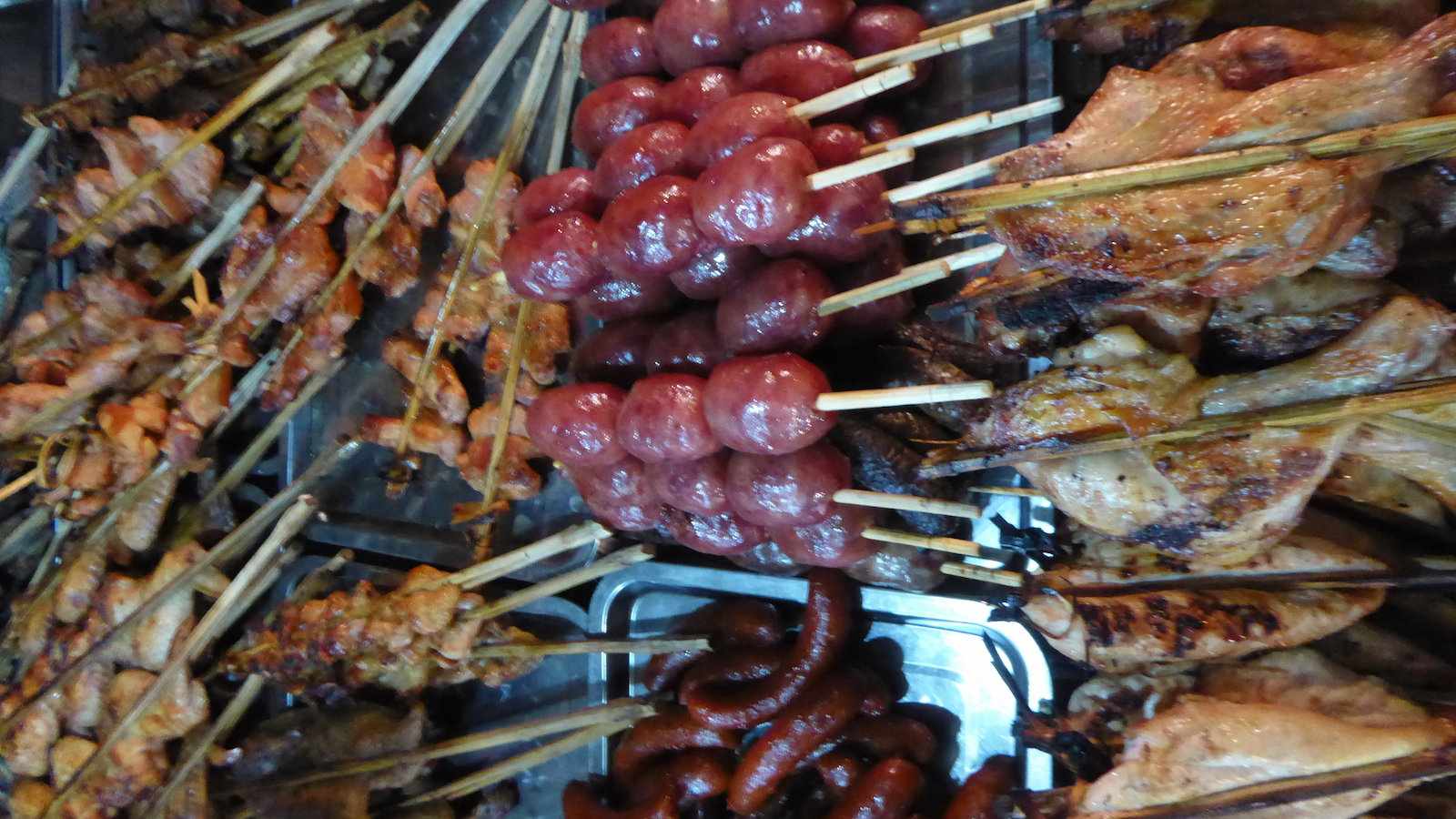
2. Larb (Laap) – Laos meat salad
One of the most famous dishes of Laos and the country's unofficial national dish is larb. Larb (also sometimes spelled laab or laap) can be found in food markets, restaurants, and homes in Laos, as it's a very popular dish with locals. Larb is basically a minced meat salad, and the meat used can be either raw or cooked. If you don't want raw meat, look out for laap mu suk which is larb with cooked pork. Laap dip is larb with raw meat.
Along with meat, larb is made with lime juice, garlic, fish sauce, mint leaves, chili, spring onion, and ground toasted rice, which adds a subtle nutty flavor. It's often served as part of a meal with sticky rice and assorted vegetables as well. It's also possible to have vegetarian larb with tofu and mushrooms instead of meat.
In Laos, the word larb means fortune and good luck. We're not sure if eating larb made us any luckier but it's definitely a refreshing and yummy dish to eat on a hot day in Laos!
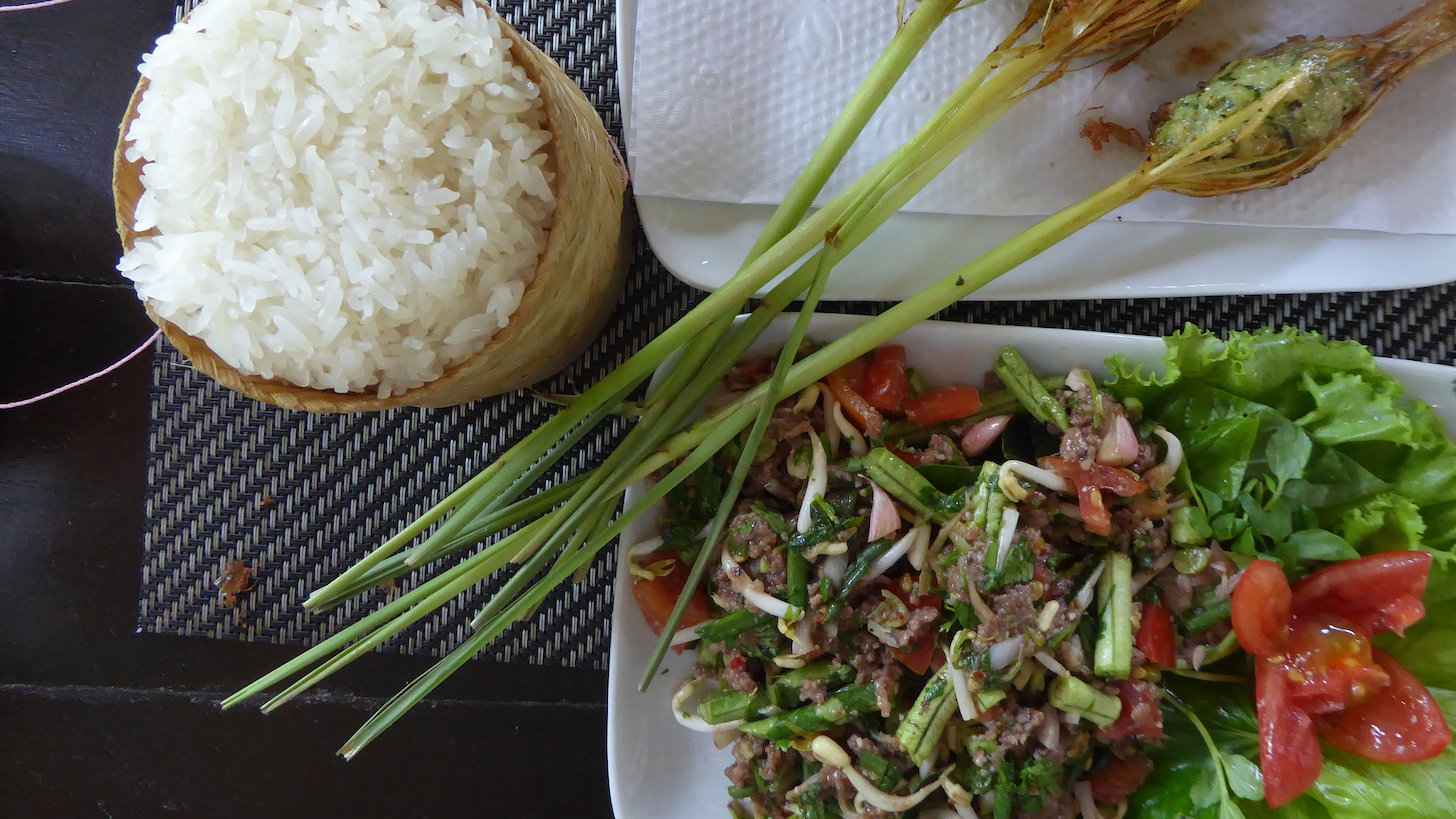
3. Khao jee – grilled sticky rice on a stick
Sticky rice is a big deal in Laos and the people consume more sticky rice than any other country in the world. A bowl of sticky rice is usually part of every meal as it's easy to eat with the hands along with other dishes.
Sticky rice is more filling and takes longer to digest than regular rice, which is partly why it's so important in Laotian culture. The people of Laos even call themselves the “children of sticky rice”!
Khao jee is a tasty way of eating sticky rice on the go, perfect for breakfast or a snack when you're in a hurry. It's made by forming little patties out of cooked sticky rice and wrapping them onto sticks so they can be flipped while cooking on a grill without burning your hands. They're usually brushed or dipped in egg, which helps make the outside deliciously crunchy and brown while the inside is still soft.
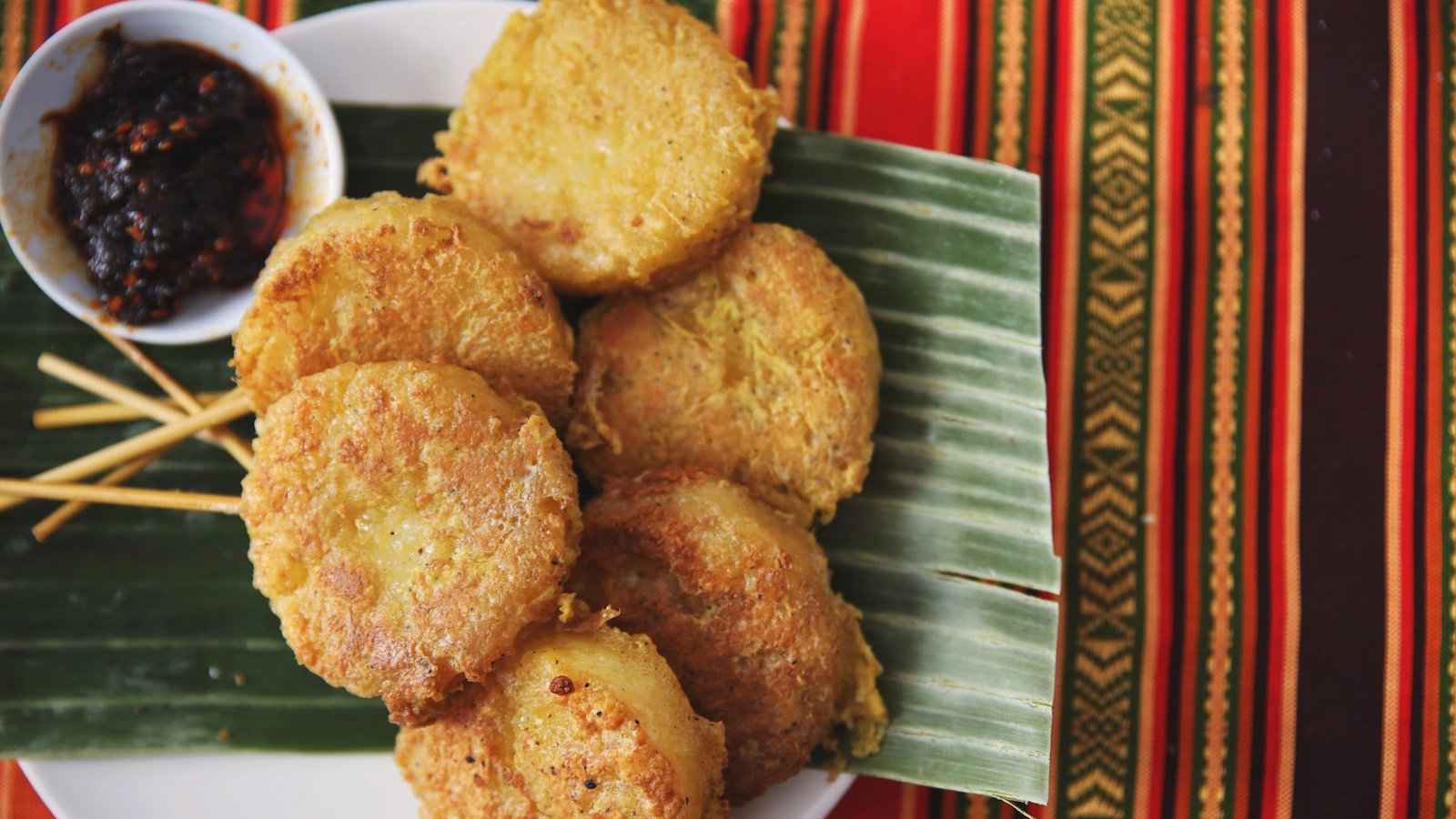
4. Pla Pao – Salted barbecued fish
As well as barbecued meats, fish is a very popular street food in Luang Prabang. You'll see a selection of different-sized fish, which have been marinated and salted, ready to then be barbecued in front of you to make a very tasty meal.
It's around 30,000 to 50,000 kips ($4-$6) for a whole fish depending on the size, which is a very good price for a whole delicious fish! Pla pao is made by coating a fish (that still has its skin on as this helps to retain moisture) with salt and stuffing it with herbs like lemongrass or kaffir lime. Once the fish is cooked the herbs seep into the flesh making it so tasty and tender.
Pla pao is also really yummy with a seafood sauce made with lime juice, fish sauce, garlic, sugar, and chilies. Don't be surprised if you also see pla pao in Thailand, as many Laotians have moved to Thailand over the years and the Thais have embraced many of their dishes with gusto!
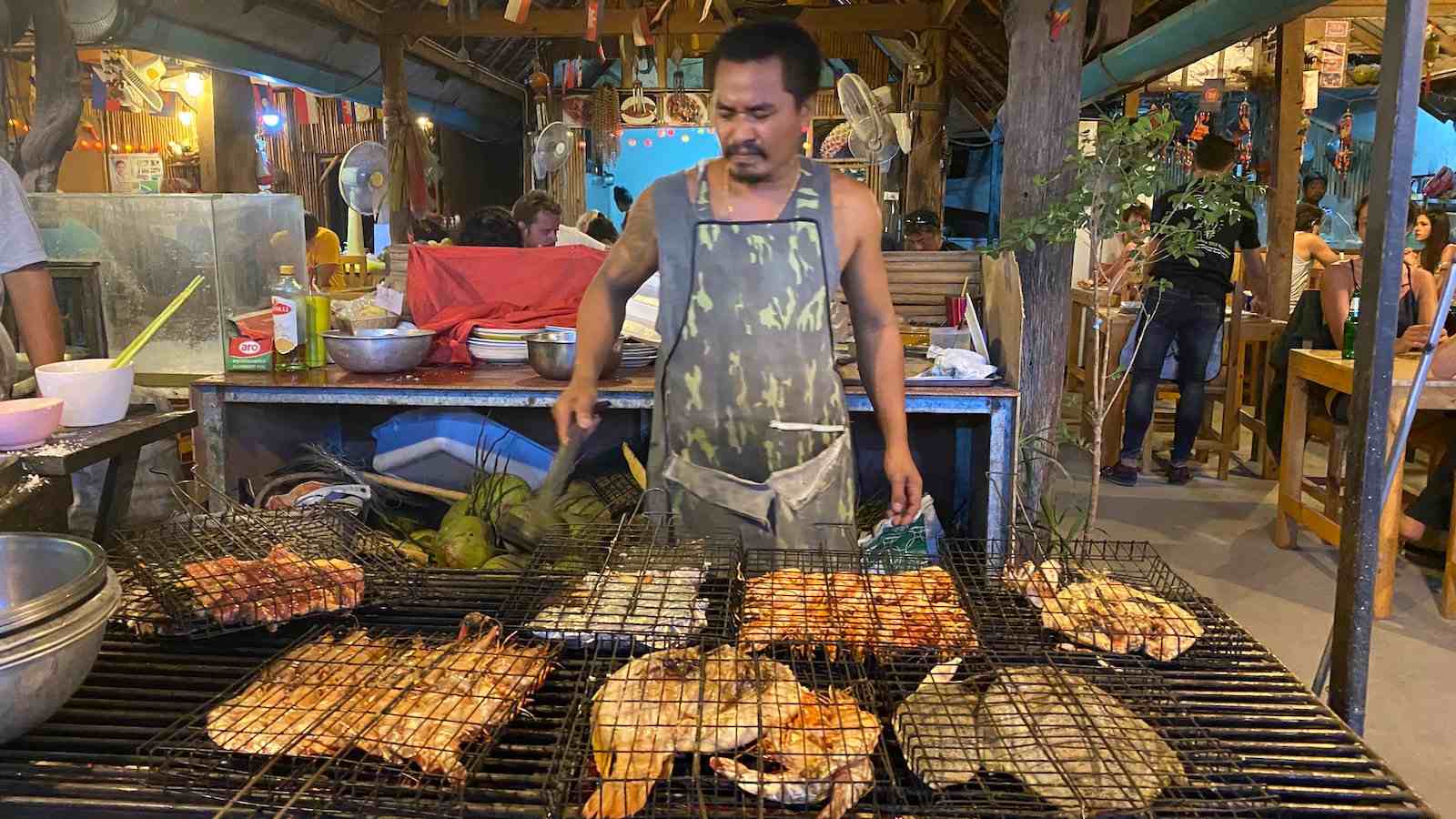
5. Sai kok – spicy Laos sausage
We don't want to be immature but it can't be just us who thinks the name kok for a type of sausage is funny, right? Sai kok is the name for a spicy sausage from Laos and while the name might seem silly to English-speakers, the tastiness is no joke!
Sai kok is made from chopped-up fatty pork flavored with lemongrass, galangal, kaffir lime leaves, red chilis, garlic, shallots, and fish sauce. We found it interesting that sai kok actually comes from the Isan region of Thailand, which is home to roughly six times more ethnic Lao than in Laos itself. Luckily you can get sai kok in Laos and Thailand nowadays, as it's been embraced by both countries.
This spicy sausage has a distinctive and deep flavor because it's usually left to infuse for a few days before being sold. The sausage is then grilled, which helps to allow the pork to release more of the succulent flavors.
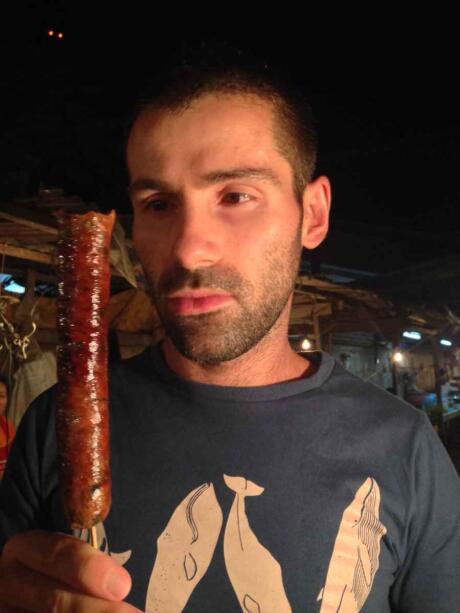
6. Baguette sandwich from Luang Prabang
There are many colorful stalls in Luang Prabang and the capital of Vientiane selling various baguette sandwiches for as little as 10,000 kips each (84p / $1.30). This may not seem anything special, but in Asia where the carbohydrate staple is rice and noodles, you do miss good bread.
Baguettes were brought to Laos when it was a part of French Indochina in the 1800s. The French influence still holds some sway in the country, particularly when it comes to these tasty sandwiches that are perfect for eating on the go. These baguettes are also big enough to share, or to keep you going even if you have a big appetite *cough* like Stefan!
If you are in Laos and see these stalls, we can also recommend their yummy shakes, smoothies, and coffee to go with your baguette. The cups of fruit can either be bought to be eaten or they will make them into a smoothie in front of you.
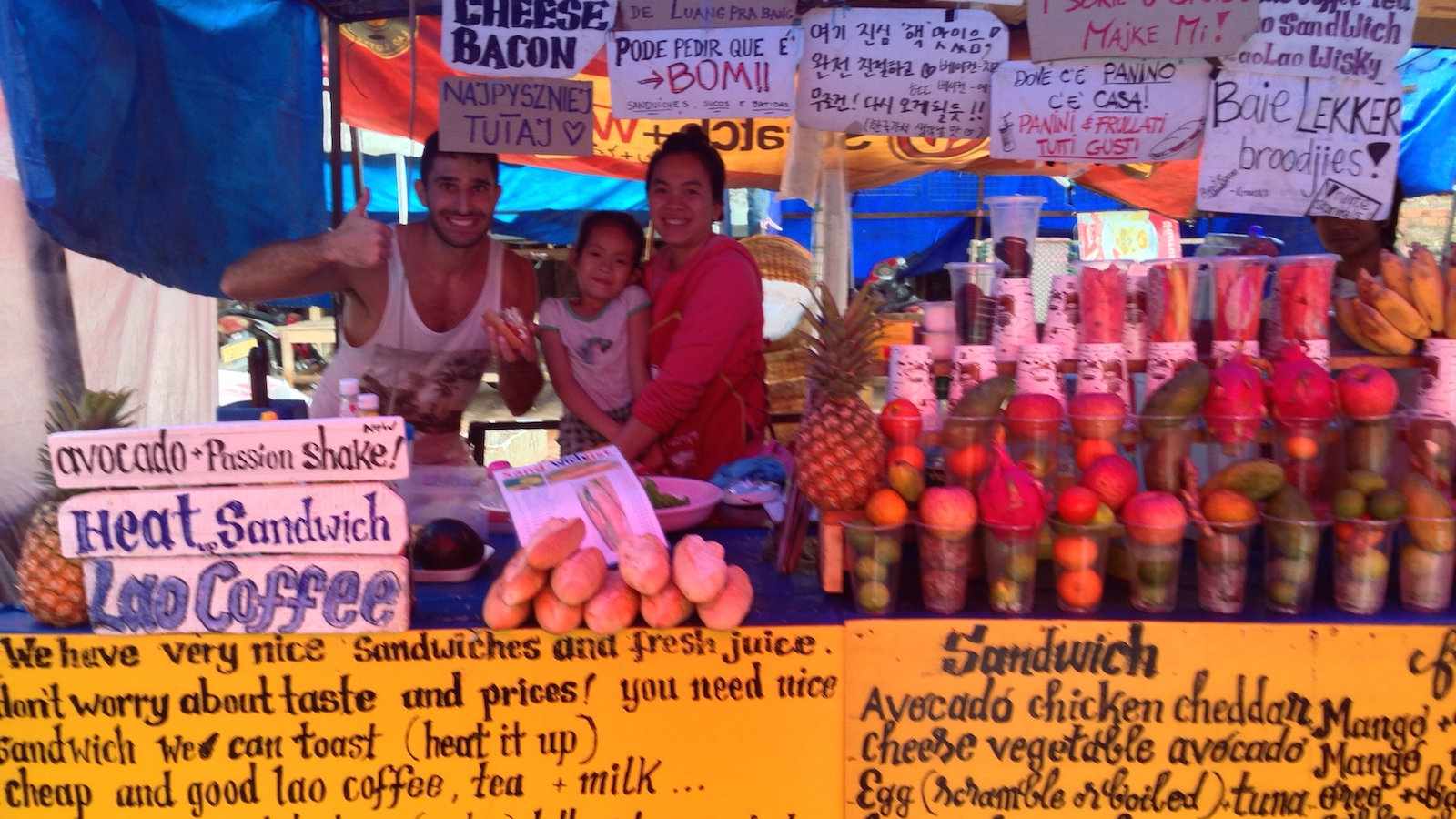
7. Laos khao soi (and other noodle soups)
Noodle soup is staple street food in Luang Prabang and in Laos generally. We struggled at first with it in the local restaurants because of the variety of very questionable meats used. This is not the case at the night market, which has been adapted for foreigners and contains proper meat.
If you like noodle-based soups you have got to try khao soi while you're in Laos, although don't go thinking it tastes the same as the Thai version of the same name. Khao soi comes from the northern parts of Laos, where a type of fermented soybean paste called thua nao originates from a town close to the Chinese border. This is one part of the soup that gives it such a distinctive flavor.
Khao soi is made with fresh, wide-cut rice noodles and broth, which is then topped with a sauce made from thua nao, tomato, vinegar, palm sugar, and chili powder. Diners are usually also given plenty of fresh vegetables and herbs to add to the soup to suit their own tastes.
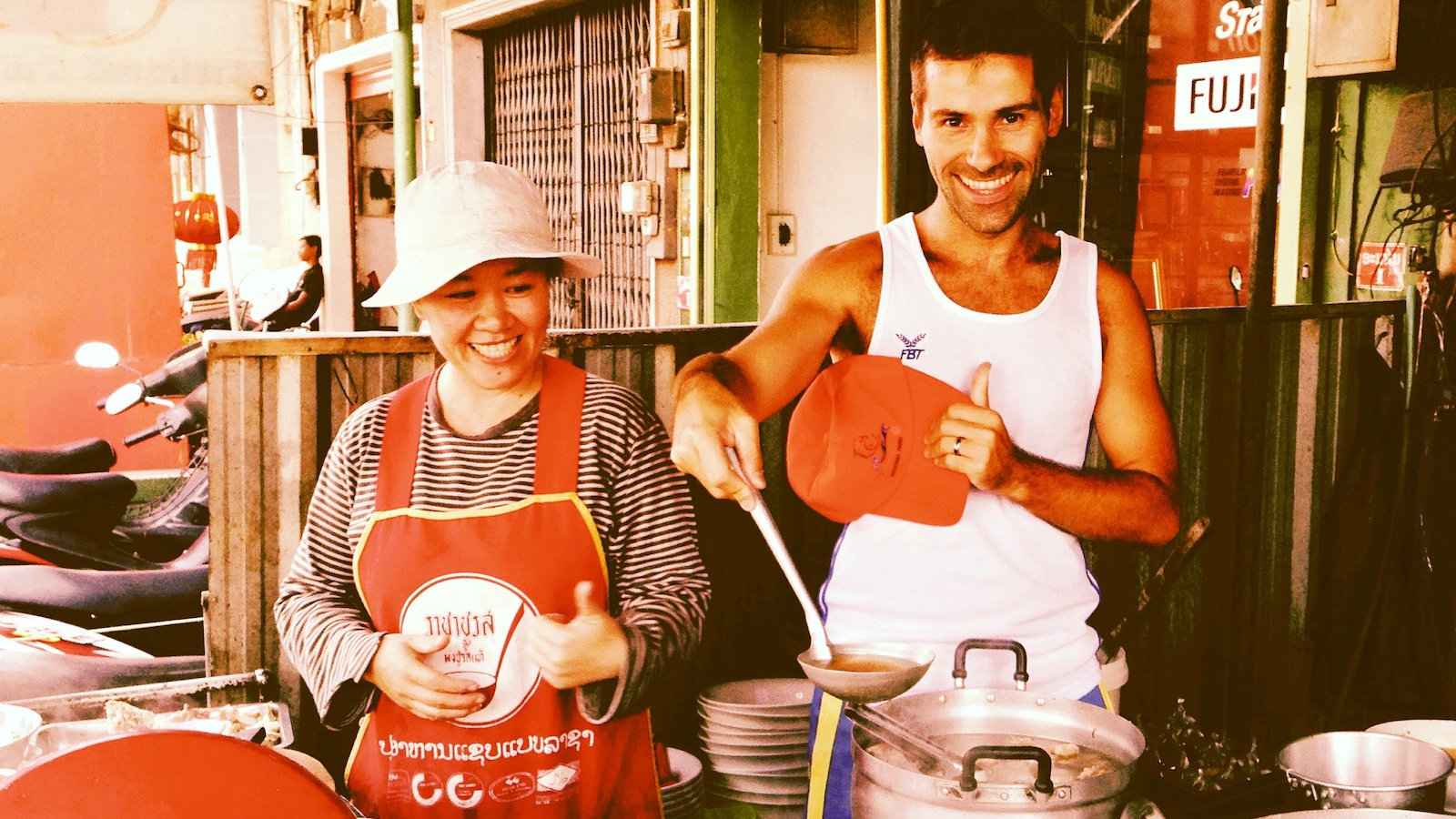
8. Fresh sugar cane juice
Sugar cane was our exciting ‘discovery' from the street food in Yangon, Myanmar. It is also available everywhere in Luang Prabang street stalls and it's called nam oi in Laos. Pretty much anywhere that sugarcane is commercially grown you should be able to find sugarcane juice also being sold locally.
The person working the stall will have sticks of peeled sugar cane and a contraption that looks a bit like a normal fruit juicer. The sugarcane is squeezed through this machine so that the juice comes out, which is then served fresh with just a straw.
Of course, sugarcane juice is naturally sweet so nothing needs to be added to the delicious drink. It's also very refreshing on a hot day, quenching your thirst better than coca-cola. For extra yumminess, add a pinch of salt – you won't believe how good it is! Make sure you try some if you're ever in Laos.
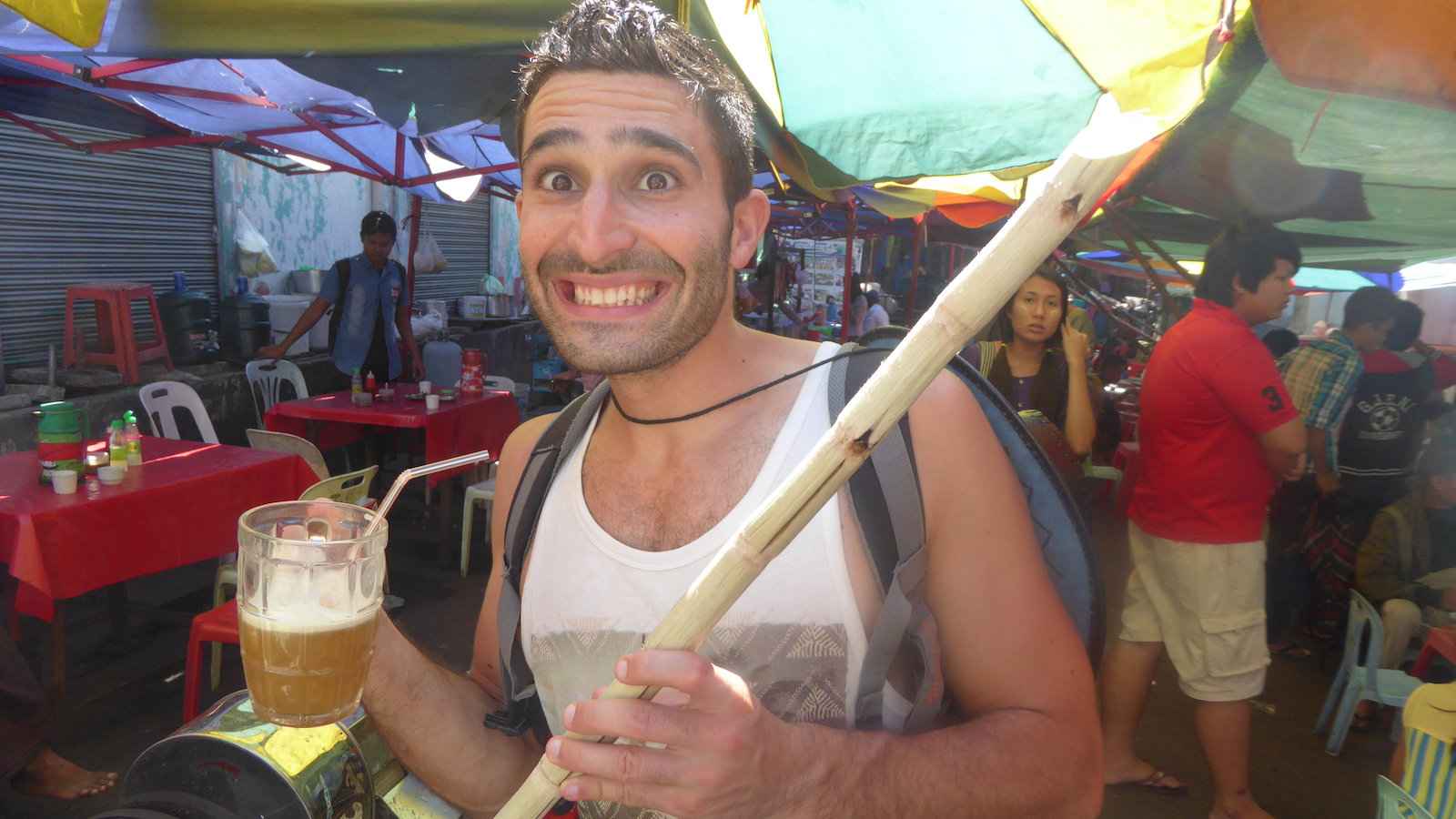
9. Tam mak hoong – Laos papaya salad
You've probably heard of som tam, the Thai take on a spicy papaya salad. We found out this healthy salad actually originated from Laos where it's called tam mak hoong and was introduced to central Thailand by Lao immigrants. Nowadays you can find variations of it throughout Thailand, Cambodia and Vietnam but if you want to try the original, head to Laos!
Laos papaya salad is a very popular street food in Luang Prabang, made from shaved green papaya with a cucumber-like consistency, lots of lime juice, garlic, dried shrimp, chili, palm sugar, tomatoes, and the fermented fish sauce called padaek. There are many stalls dotted around the night markets in Laos where it is prepared and sold.
Tam mak hoong is quite spicy, but if you have it with some sticky rice that helps dull some of the fire. We loved the fresh, flavorful ingredients, especially with the mix of sweet and sour tastes.
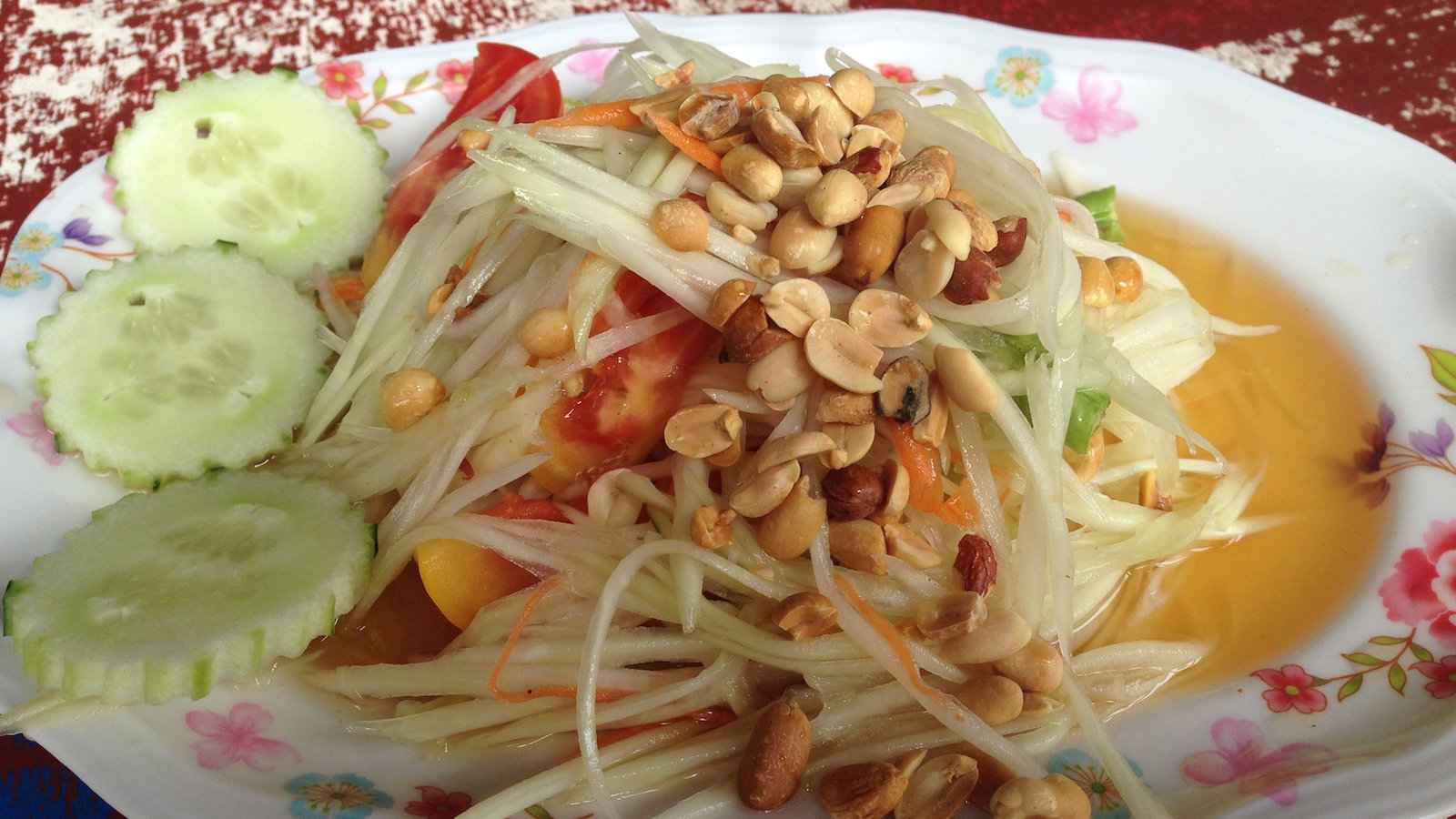
10. Khao nom kok – Laotian coconut pancakes
Khao nom krok (also sometimes written as kanom krok) are small pancake-like desserts made from whisked coconut milk, sugar, tapioca starch, and rice flour. They're cooked over a charcoal brazier in special khao nom krok cast iron pans with little half-moon dips in them for the batter, they look just like the ones the Dutch use for their tiny pancakes (called poffertjes).
You'll find a few stalls at the entrance to the food area of the night market in Luang Prabang selling khao nom kok, and they're a super-tasty treat, especially considering how simple the ingredients are. Two half-circle shapes are sandwiched together and usually served sitting in banana leaf bowls with toothpicks to eat them with.
These little coconut pancakes are so yummy, we found ourselves gobbling them down whenever we had the chance. The outsides are crispy while the insides are smooth, silky, and absolutely melt in your mouth! Seriously, you can't just stop at one… or even four…
11. Sakoo yat sai – Tapioca fried dumplings
Those who can't eat gluten will love Laos, with its abundance of rice flour and tapioca snacks. Sakoo yat sai is a type of dumpling made of tapioca pearls filled with caramelized pork, pickled radish, and peanuts. They're on the healthier side because they are steamed or boiled instead of fried.
The meat filling is cooked first and allowed to cool completely, then it's wrapped in soaked and strained tapioca pearls before the whole parcels are steamed. They're usually garnished with cilantro and dried red chilies, while sometimes being wrapped in lettuce when served. We love the contrasts in these little balls of yumminess; crunchy peanuts mixed with soft tapioca as well as the sweet, savory, and spicy flavors.
One very friendly man works alongside his wife at the street food market of Luang Prabang. She prepares the noodle soup and he prepares the fried dumplings. This was our favorite spot to grab some sakoo yat sai as an appetizer with some of the lovely noodle soup, then heading further into the market for our next course!
12. Khao Niew Mak Muang Sii Faa – Mango sticky rice
After a spicy Laos meal the perfect dessert to cool down again is mango sticky rice. Many Asian countries have versions of this treat but since Laos is so big on glutinous rice, we have to admit we think they might just do the best mango sticky rice out there!
Mango sticky rice is made by cooking glutinous rice in coconut milk with sugar and then serving it with slices of fresh, ripe mango. In Laos, this dish is often garnished with sesame seeds, while sometimes black or a mix of black and white rice is used to make purple sticky rice – which looks extra pretty when edible flowers are also used as a garnish.
Even if you're not a big sweet-tooth, this is a luscious dessert that's not too sugary, but still just right if you need something sweet after a savory meal. Anybody else gets that, or is it just me?
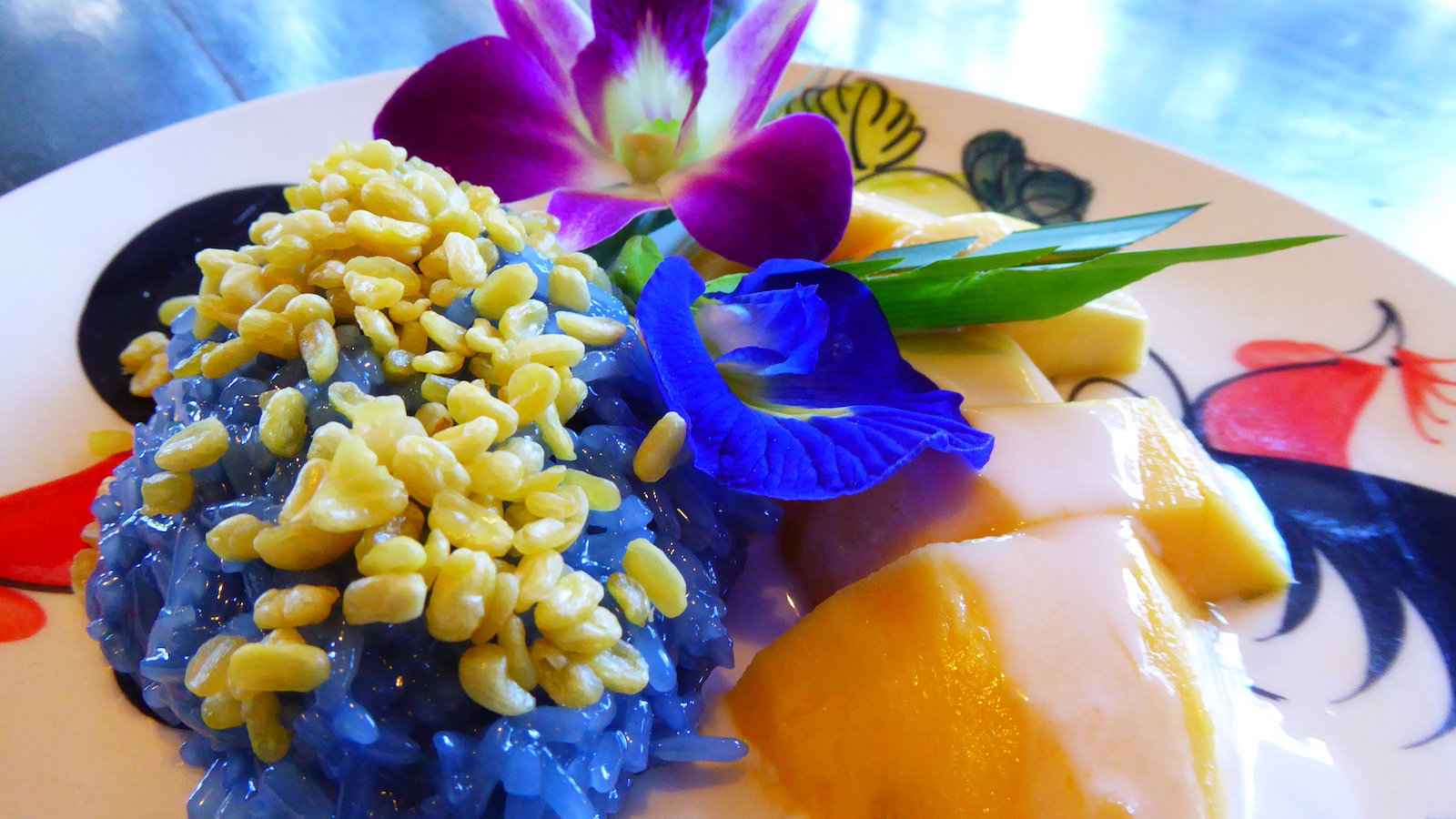
13. Khanom khuu – Laotian donut
If you're craving some carbs made from actual wheat while you're in Laos, look out for some khanom khuu at the markets or street food stalls. Khanom khuu is basically the Laos version of a donut, although they're either long or cross-shaped rather than round with a hole in the middle.
Khanom khuu (sometimes also called kao nom kou) is made with a dough of flour, sugar, salt, water, baking powder, and baking soda. This dough is left overnight before being shaped into long pieces and deep-fried in oil. These donuts were brought to Laos by the Chinese, who make their own version of long, deep-fried pastries called youtiao.
The stretching of the dough helps to make the outside crispy and the inside more hollow. Two pieces of dough are placed on top of each other to make a sort of long x shape. They're a popular breakfast food in Laos, best served freshly fried and piping hot alongside some coffee.
14. Laotian pho
While pho originated in Vietnam, it's also found its way over to Laos and become a part of the local cuisine. There are subtle differences between the pho from Vietnam and the way it is made in Laos. The main difference is that Laotians mostly use a pork base with crispy pork on top whereas, in Vietnam, chicken or beef is usually the meat of choice.
Other ingredients in pho include noodles along with herbs, vegetables, and sauces, which can differ depending on the region or what's available. In Laos, a bit of sugar is also included in pho, which again separates it from the Vietnamese version.
Pho is generally served with different sauces (like hoisin and chili) on the side as well, so you can adjust the flavors to your liking. Lime wedges are also a must pretty much everywhere, while in Laos you'll probably also get some extra sugar and shrimp paste to add on top.
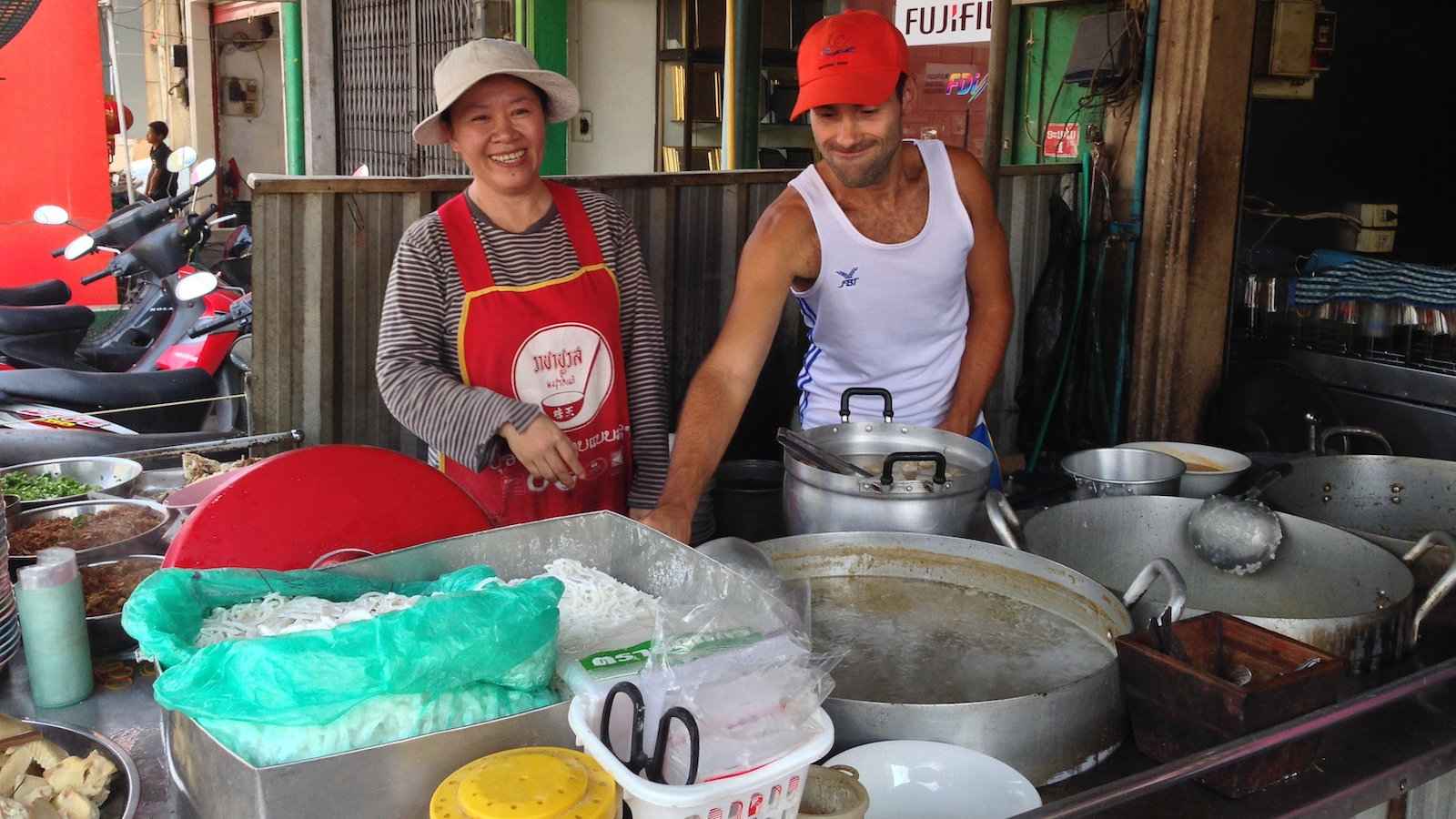
15. Nam Khao (Laos crispy salad)
Nam khao (also sometimes spelled naem khao) is a crispy rice salad that originated in the area around Vientiane but can be found in street stalls and restaurants all over the country now. The nam part of the dish is cut up fermented pork sausage while the khao is crispy rice made by pulling apart deep-fried rice balls.
Other ingredients that make up the salad include chopped peanuts, grated coconut, sliced scallions or shallots, mint, cilantro, lime juice, fish sauce, and chillies. Unlike most Laotian dishes, this salad is made using jasmine rice rather than glutinous rice. The end taste is unlike anything we've had before, a mix of crunchy, chewy rice with a combination of tart, salty, spicy and sweet flavors.
You can eat nam khao on the go by getting it wrapped in a lettuce leaf but in restaurants, you'll see it plated up like in the photo below.
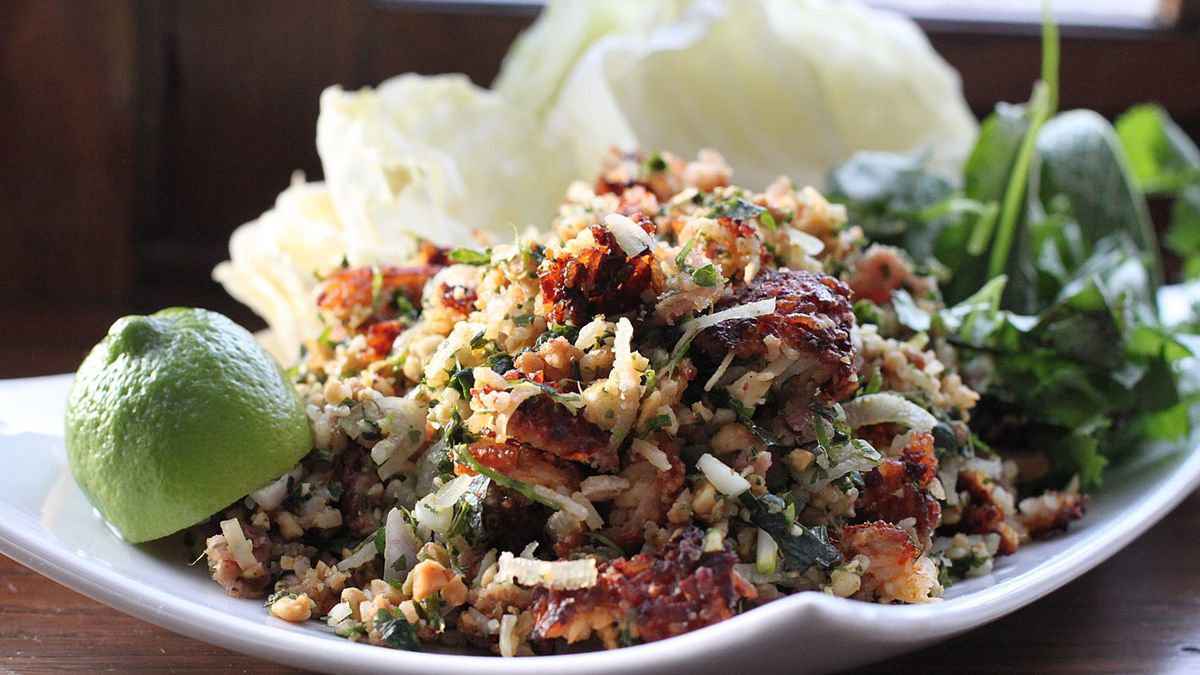

Advice for LGBTQ travelers to Laos
Laos is generally gay friendly. At no stage did we ever experience any problems anywhere in the country as a gay couple. The Laotians are very respectful, charming, welcoming, and curious with foreigners. Luang Prabang is the most touristic part of Laos, full of people from all over the world. Here especially you'll have no issues as an LGBTQ traveler. Getting a double bed was never a problem for us in any of the hotels or guesthouses we stayed at during our trip to Laos. For more, read our interview with our dear friend Somphorn (RIP) about what gay life in Laos is like.
Happy travels are safe travels
We recommend you always take out a reputable travel insurance before your next vacation. What happens if you suffer from illness, injury, theft, or a cancellation? Many travelers forget about it and regret it when something happens. Better to pay a small price and have the peace of mind and not worry.
For more inspiration:
- Read these interesting facts about Laos that you might not have known already
- Check out the best traditional Thai foods
- As well as our gay country guide to Thailand
- If you like Laos cuisine you'll also want to read about the most delicious dishes from Vietnam
- Find out some more interesting facts about Vietnam
- And use our gay travel guide to Ho Chi Minh City if you're planning a visit to Vietnam's capital
Like this post? Pin it
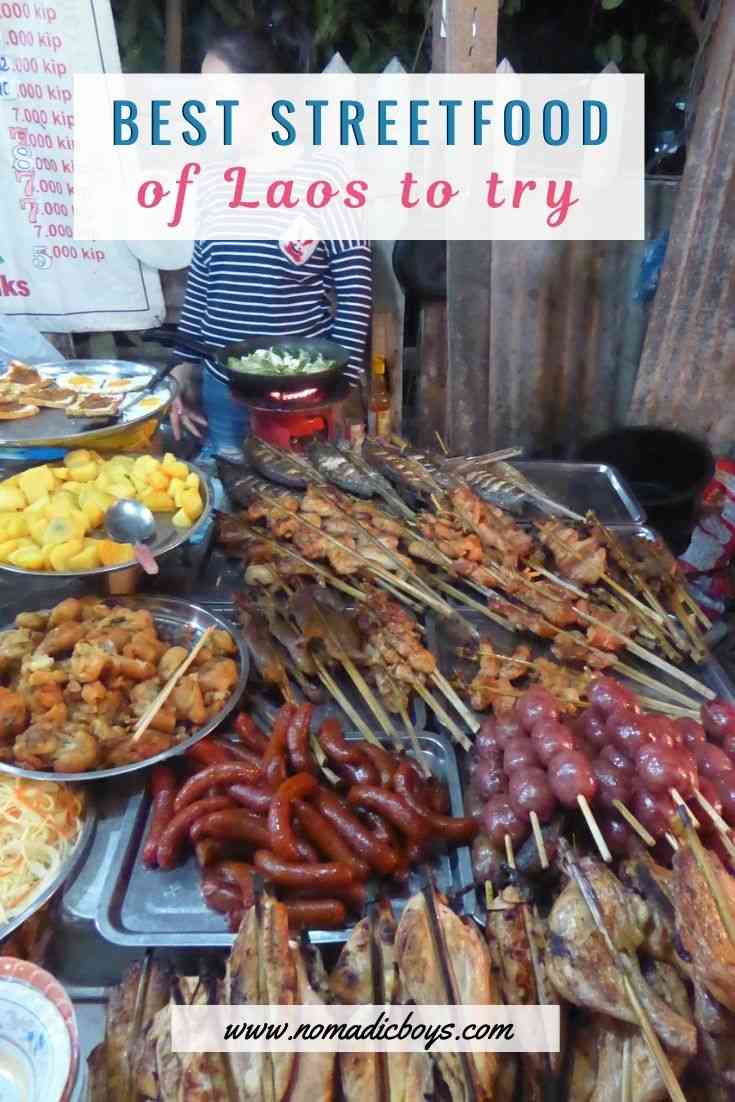

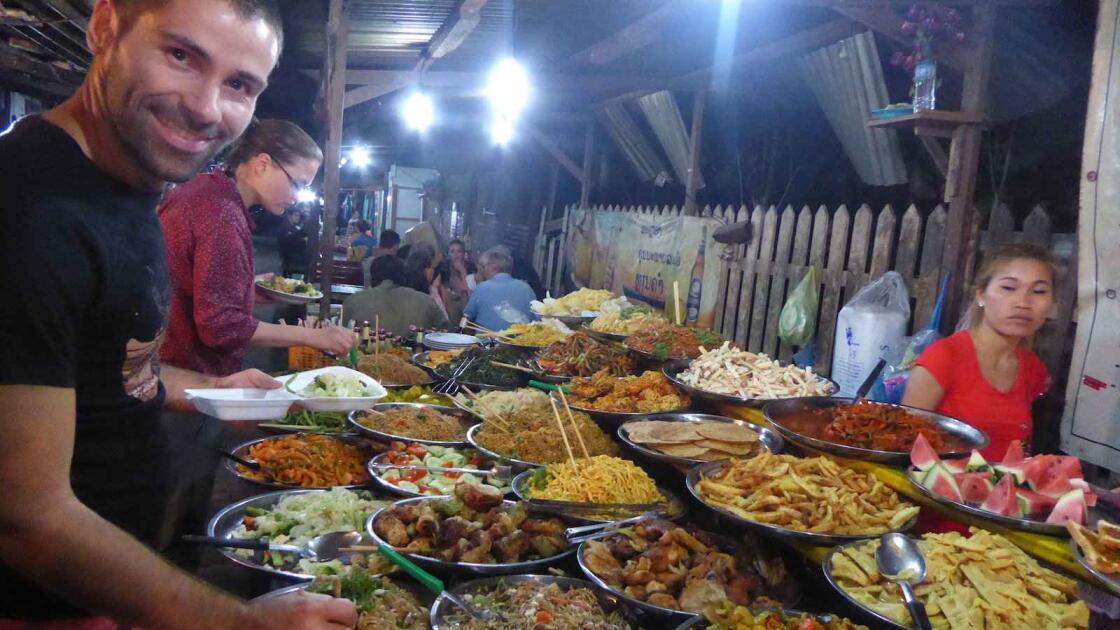

Toy Capp
Tuesday 13th of April 2021
Hi
Very nice. The only thing I would like to mention's #11 SaKoo Yat Sai not fried but steamed or boiled.
Stefan Arestis
Wednesday 14th of April 2021
Thanks :)
Mateusz
Tuesday 21st of January 2020
Hi, nice. Where to find that "10. Fried dumplings"? I love dumplings, have to try that ones :)
Stefan Arestis
Tuesday 21st of January 2020
Right? It's one of our favourites :)
tONKIN - TRAVEL VIETNAM
Thursday 30th of November 2017
Your video is so cool, especially the scene of jumping into the waterfall. Love it. Regarding fruits, you can find it easy in most of Asian countries. Heaven for fruits may be Thailand and Vietnam. Anyways, thanks for your post.
Nomadic boys
Thursday 30th of November 2017
Thanks for reading :)
Friday 10th of February 2017
5
Sunday 11th of December 2016
2.5